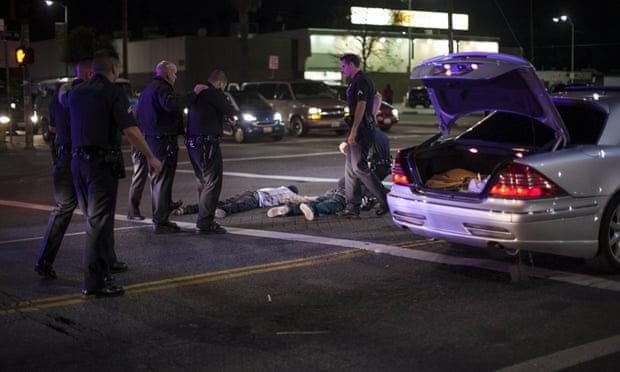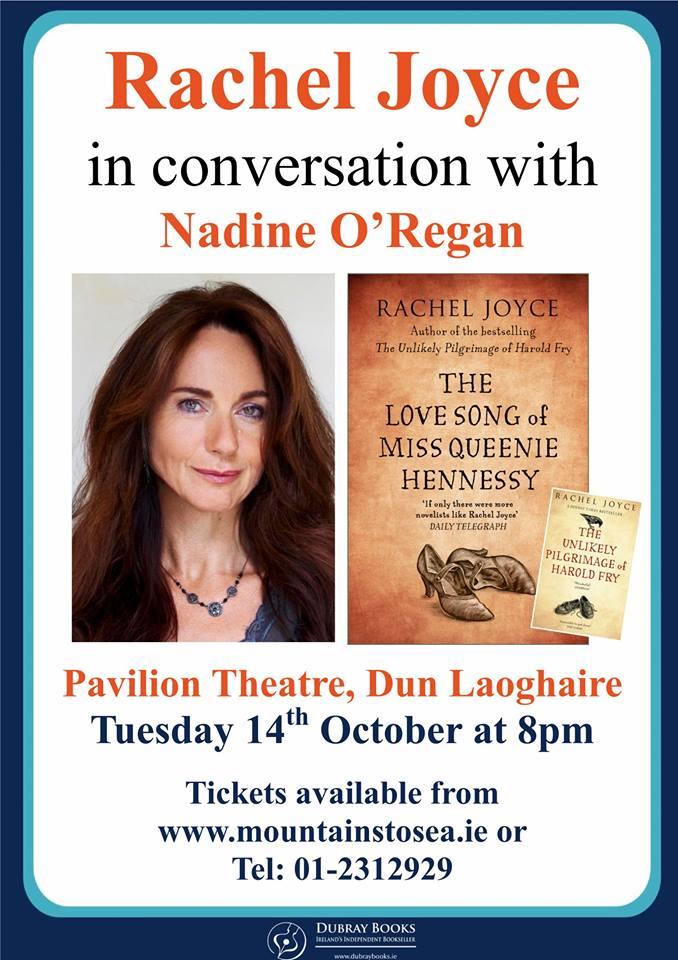Ghettoside: Investigating a Homicide Epidemic by Jill Leovy – Review
By focusing on just one killing in Los Angeles’ most violent district, Jill Leovy's powerful and gripping book provides clues as to how lawlessness takes hold.
See her at #M2C2015 on Wednesday March 18th at 6.30pm in conversation with Declan Hughes Pavilion TheatreGuardian review of Ghettoside; http://gu.com/p/45p54/stw
 A brutal history … the LAPD on the beat. Photograph: Robert Nickelsberg/Getty Images
A brutal history … the LAPD on the beat. Photograph: Robert Nickelsberg/Getty Images
In 2007,
Jill Leovy started a blog on the LA Times site called
Homicide Report, an attempt to chronicle every one of the 845 homicide deaths that took place in Los Angeles County that year. The blog, which is still running, has the motto “a story for every victim”, and takes a sober, data-driven approach to this most emotive of subjects. A veteran crime reporter, Leovy already had strong connections with LAPD homicide detectives, which she used to flesh out the entries in the LA county coroner’s database, trying to understand the reasons why people kill and are killed. Controversially, the blog runs statistics about race – controversially in part because those statistics underline a stark and unpalatable fact. In 2013, “Blacks, just 8% of the county’s residents … accounted for 32% of all homicides … blacks were killed at more than seven times the rate of all other racial and ethnic groups combined.”
Who is killing black people? The answer is: mainly other black people. Roiled by a new movement against police brutality, the US is currently burying its head in the sand so as not to have to face up to the disproportionate violence meted out to black Americans by law enforcement. Those who wish to minimise or condemn the “black lives matter” protests frequently point to statistics about black-on-black killings in order to suggest that African Americans are predisposed to violence or crime, and so presumably deserve the treatment they get. The left has not done well in rebutting racist interpretations of homicide statistics. InGhettoside, Leovy, who is well qualified for the task, has committed herself to understanding why black people are “the nation’s No 1 crime victims … the people hurt most badly and most often, just 6% of the country’s population, but nearly 40% of those murdered.”
Leovy chooses to focus on the 77th Division in the South Central district of LA, made notorious in the 80s and early 90s by gangsta rappers like
NWA. “South of the 10”, the east-west highway that forms an unofficial boundary between wealthy and fashionable West LA and historically deprived neighbourhoods like Compton and Watts, is the location of the vast majority of the city’s black-on-black homicides. The 77th includes the intersection of Florence and Normandie, the epicentre of the 1992 riots. It’s a far cry from Beverly Hills. “Cops knew these places for their boxy apartments, chain-link fences, converted garages, bad dogs with no collars, and Chevy Caprices.” Policing these areas is tough, thankless and, Leovy writes, not generally considered a springboard for an ambitious career in the LAPD. Homicide detectives are shockingly under-resourced and culturally marginalised in a police department which sets great store by uniformed patrolling and “proactive” initiatives like gang takedowns, rather than after-the-fact investigations.
Leovy touches briefly on the social forces that created LA’s ghettos – restrictive covenants on housing in more desirable areas, preventing sale to blacks, mass migration from Louisiana and Mississippi – but never deals with this history in depth. This is not a “big picture” book about
Los Angeles in the mode of Mike Davis’s magisterial
City of Quartz. Instead, she adopts the familiar format of the police procedural, introducing us to a team of heroic hard-bitten detectives and narrowing her story down to one particular murder, the random and apparently motiveless killing of a black teenager called Bryant Tennelle, whose father happened to be an LAPD detective.
Unlike the majority of LAPD officers, who live outside the city, commuting in from majority-white suburbs in Orange County or Ventura, the Tennelle family lived in the 77th, a decision considered unwise by fellow officers. The disconnection of police from the communities they serve is a long-standing complaint across the United States, and undoubtedly contributes to the impression that forces like the LAPD (or for that matter the police in Ferguson, Missouri) act as militarised “occupying armies”, instead of an organic part of the social structure. Officers, on the other hand, fear that their families would be put at risk, and in many cases are straightforwardly priced out of attractive city neighbourhoods by high property prices. Leovy has sympathy for the dangers and difficulties faced by police, and while she acknowledges the LAPD’s brutal history, she sometimes soft-pedals the frank hostility of many officers to the people they are pledged to protect and serve. Reviewing the disastrous failure to protect witnesses in homicide cases, a major obstacle to successful convictions, she notes that “some cops, steeped in rightwing rhetoric about the ‘nanny state’, harboured deep philosophical objections to aiding witnesses with cash. One detective supervisor … saw it as her duty to make sure they got as little state money as possible. She considered the division’s poor to be welfare malingerers and did not want to abet their sponging ways.” The next paragraph reassures the reader that “experienced homicide detectives did not share this view”, but it’s clear from her book that such enlightened souls are in a minority. One has the sense that her narrative (and her access as a journalist) would not be served by dwelling on issues of structural racism.
Leovy’s detective heroes are described as a breed apart from their colleagues, who tend to view most killings of young black men as an inevitable product of gang culture, unofficially filing them as “NHI” – “no human involved”. We follow them as they interview witnesses, put in hours of punishing overtime and skilfully circumvent bureaucracy in search of the truth. It’s a mode of storytelling familiar from
David Simon’s
Homicide: A Year on the Killing Streets, the groundbreaking 1991 account of murder investigations in Baltimore that formed the germ of
The Wire. Stylistically, Simon casts a long shadow over Leovy, who doesn’t have his ear for dialogue or his deftness with character. What she does have, and what sets
Ghettoside apart from the slew of factual police procedurals published every year, is a compelling analysis of the factors behind the epidemic of black-on-black homicide, and the beginnings of a policy prescription for tackling it. This makes
Ghettoside an important book, which deserves a wide audience.
“High homicide environments are usually alike,” Leovy writes. Summarising anthropological work in cultures with high murder rates, she notes that the setting is usually a minority enclave or disputed territory where people distrust legal authority. The majority of killings arise out of arguments, sometimes formalised into feuds. Small conflicts escalate. Women often “work through men” by “agitating them to homicide”. The distrust of authority is the key. In the absence of a legal system that people trust to work for them, killings are the only way to settle disputes or exact revenge. “History shows us that lawlessness is its own kind of order.”
It’s not as though black communities are under-policed. The famous “broken windows” theory of James Q Wilson and George L Kelling, which holds that preventing small transgressions (street drinking, loitering, vandalism and so on) creates an atmosphere of lawfulness and thus leads to an overall drop in crime, has been the making of a number of political careers, particularly in New York, where its application has been credited (perhaps wrongly) with transforming the city. In Los Angeles and elsewhere, “broken windows” often sends large numbers of police officers into minority neighbourhoods, on a mission to make arrests and hand out tickets for minor offences. Unfortunately, when combined with the low clear-up rate for serious crimes in these same neighbourhoods, and the palpable attitude of callousness shown by patrol officers (portrayed in Leovy’s book as largely cynical and apathetic) the result is a force that appears to be harassing and penalising people of colour, while turning a blind eye to serious suffering. One of the key demands of the New York civil rights movement that coalesced after the choking death of
Eric Garner (confronted over a classic broken windows offence – selling loose cigarettes) is an end to the NYPD’s policy of “stop and frisk”, a tactic that is disproportionately applied to young minority men. British readers may remember similar anger about the so-called
“sus law” in the 1970s and 80s.
So how does one build trust in the police? Any kind of community outreach will, argues Leovy, be absurd unless black-on-black homicide is taken seriously. It is unacceptable to file young dead black men as “gang-related” casualties and treat their deaths as victimless crimes. This is not sentimentality or excessive liberal sympathy for criminals, but a policy that (quite apart from being just and decent) would regain consent for the presence of police in areas where they are currently seen as antagonists, the officer (as rapper
KRS-One memorably put it) as overseer. As one detective remarks, “catching killers builds law”. Leovy provides examples where prompt and vigorous investigation prevented friends and relatives of murder victims from acts of revenge, stopping feuds before they took more lives. Self-evidently, the vast majority of residents in any community, black or white, are not criminals, but in lawless areas, even the law-abiding must live under a gang-enforced code that proscribes cooperation with the police under any circumstances. Coupled with the LA judicial system’s woeful failure to protect witnesses, making any kind of case is hard for overstretched homicide detectives working with such meagre resources that they are apparently forced to buy their own office equipment. Though Leovy avoids the larger and thornier questions about law enforcement in African American communities (gun control, the zombie-like persistence of
Jim Crow), her balanced and unhistrionic book may, with luck, persuade the “I can breathe because I obey the law” crowd, those Americans who have historically been unreceptive to other kinds of argument, to look again at black-on-black homicide, and take action.










